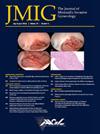SYNAPPH 研究:产后大出血后子宫峡部的患病率,一项试验性研究。
IF 3.5
2区 医学
Q1 OBSTETRICS & GYNECOLOGY
引用次数: 0
摘要
研究目的前瞻性评估经药物治疗的产后出血(PPH)后宫腔内褥疮的发生率,并评估褥疮形成与PPH处理技术之间的关联:设计:一项前瞻性观察性队列研究:参与者: 共 83 名产妇:研究共纳入2021年1月至12月期间接受药物治疗的83名PPH妇女:干预措施:产后12周进行诊断性宫腔镜检查,以评估是否存在子宫缝合。收集有关PPH处理技术的详细数据进行分析:大多数参与者为初产妇,经阴道分娩。只有7%的患者需要宫腔内球囊填塞术(IUBT),4%的患者接受了子宫动脉栓塞术。20名产妇在诊断性宫腔镜检查中发现了子宫鞘膜积液,产后12周时的发病率为24%;根据ESGE分类系统,所有子宫鞘膜积液都属于I型。15%的合并膀胱阴道畸形妇女使用了IUBT,而非合并膀胱阴道畸形组中仅有5%使用了IUBT,但这一差异并无统计学意义(OR 3.52,95% CI 0.65-19.10,P=0.123)。多变量分析发现,第二次人工子宫检查(OR 5.00,95% CI 1.50-16.66,p=0.009)和双人子宫按摩(OR 3.50,95% CI 1.12-10.09,p=0.020)是形成子宫峡部的独立风险因素:这是第一项评估经药物治疗的PPH患者宫内鞘膜积液风险的研究。队列中每四名妇女中就有一人出现轻度子宫峡部狭窄。需要进行第二次人工子宫检查和双人子宫按摩与子宫缝合畸形的发生密切相关。有必要开展进一步研究,以探讨长期的临床后果,包括生育结果,并确定诊断性宫腔镜检查在PPH产后随访中的潜在作用 总结:该研究前瞻性地调查了非手术产后出血后子宫内膜异位症的发生率,结果显示其发生率为24%,第二次人工子宫检查和双人子宫按摩被认为是独立的风险因素。本文章由计算机程序翻译,如有差异,请以英文原文为准。
The SYNAPPH Study: Uterine Synechiae Prevalence After a Postpartum Hemorrhage, a Pilot Study
Study Objective
To prospectively assess the prevalence of intrauterine synechia following medically treated postpartum hemorrhage (PPH) and to evaluate the association between synechiae formation and PPH management techniques.
Design
A prospective observational cohort study.
Setting
Angers University Hospital.
Participants
A total of 83 women presenting with medically treated PPH from January to December 2021 were included in the study.
Intervention
Diagnostic hysteroscopy was performed twelve weeks postpartum to assess for the presence of uterine synechiae. Detailed data on PPH management techniques were collected for analysis.
Measurements and Main Results
The majority of participants were primiparous and had undergone vaginal delivery. Only 7% required intrauterine balloon tamponade (IUBT), and 4% underwent uterine artery embolization. Uterine synechiae were identified in 20 women during diagnostic hysteroscopy, yielding a prevalence of 24% at 12 weeks postpartum; all classified as type I according to the ESGE classification system. IUBT was used in 15% of women with synechiae compared to 5% in the nonsynechiae group, although this difference was not statistically significant (OR 3.52, 95% CI 0.65–19.10, p = .123). Multivariate analysis identified second manual uterine examination (OR 5.00, 95% CI 1.50–16.66, p = .009) and bimanual uterine massage (OR 3.50, 95% CI 1.12–10.09, p = .020) as independent risk factors for synechiae formation.
Conclusion
This is the first study to evaluate the risk of intrauterine synechiae following medically treated PPH. Mild uterine synechiae were observed in one in four women in the cohort. The need for a second manual uterine examination and bimanual uterine massage were significantly associated with the development of synechiae. Further research is warranted to explore the long-term clinical consequences, including fertility outcomes, and to determine the potential role of diagnostic hysteroscopy in postpartum follow-up after PPH.
Summation
The study prospectively investigates the prevalence of uterine synechiae following nonsurgical postpartum hemorrhage, revealing a 24% occurrence, with second manual uterine examination and bimanual massage identified as independent risk factors.
求助全文
通过发布文献求助,成功后即可免费获取论文全文。
去求助
来源期刊
CiteScore
5.00
自引率
7.30%
发文量
272
审稿时长
37 days
期刊介绍:
The Journal of Minimally Invasive Gynecology, formerly titled The Journal of the American Association of Gynecologic Laparoscopists, is an international clinical forum for the exchange and dissemination of ideas, findings and techniques relevant to gynecologic endoscopy and other minimally invasive procedures. The Journal, which presents research, clinical opinions and case reports from the brightest minds in gynecologic surgery, is an authoritative source informing practicing physicians of the latest, cutting-edge developments occurring in this emerging field.

 求助内容:
求助内容: 应助结果提醒方式:
应助结果提醒方式:


